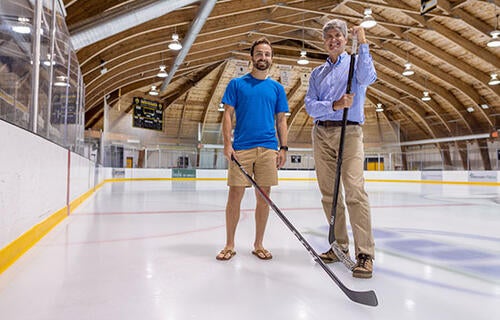
Game-changing insights using 5G technologies
Waterloo and Rogers partnership could redefine real-time hockey analytics

Waterloo and Rogers partnership could redefine real-time hockey analytics
By Jordan Flemming University RelationsIn a unique collaboration, the University of Waterloo and Rogers Communications are joining forces to revolutionize the world of hockey analytics using 5G technology. This partnership could help reshape how hockey fans engage with the game and provide teams with valuable insights for data-driven decision making.
This research partnership emerged from a 2020 hockey hackathon that was organized by Velocity, where Waterloo students had the opportunity to access proprietary NHL data sets and were tasked with generating ideas and offer new solutions that Rogers owned Sportsnet could incorporate into their viewing experiences.
The data was collected from infrared-emitting devices embedded in hockey puck and player uniforms and relayed to a state-of-the-art infrared cameras system installed in all 32 NHL arenas, including Rogers Place in Edmonton, Alberta. Thanks to the low latency and high bandwidth of 5G technology, gameplay analytics can then be transmitted in real-time to viewers smartphones or to sports broadcasters.
The hackathon caught the attention of David Radke, a computer science PhD candidate and assistant captain and defenceman on Waterloo’s varsity men’s hockey team. Radke’s research is focused on artificial intelligence and multiagent systems — a computerized system composed of multiple interacting intelligent agents. He saw it as a fantastic opportunity to blend his passion for research and hockey while exploring endeavors beyond academia and venturing into industry.

David Radke and Tim Brecht. Photo credit: Joe Petrik
After his team won the hockey hackathon for their idea of using the data to provide real-time sports analytics to viewers, Radke brought the NHL data sets to the attention of one of his graduate supervisors, Tim Brecht.
Brecht is a professor in the Cheriton School of Computer Science who conducts research to understand and improve the performance of computer systems and networks. Together, Radke and Brecht went on to publish two papers using the puck and player datasets.
“I've always been interested in performance analysis and to apply it to hockey provided us with a unique opportunity to look for statistically significant, meaningful and insightful metrics — which was very exciting,” says Brecht.
The puck and player tracking data sets are closely guarded by the NHL and are only available to the University thanks to its partnership with Rogers, a major owner of Maple Leaf Sports & Entertainment.
The central objective of this research partnership is twofold: to enhance fan engagement and to provide valuable insights to players, coaches, agents, broadcasters and even sports betting platforms.
By leveraging the power of 5G networks, this collaboration aims to offer real-time metrics and engaging visual overlays during broadcasts. This immersive experience promises to provide fans with novel insights into the game's dynamics, fostering a deeper understanding and appreciation of the sport.
The research initiative’s scope goes beyond fan engagement. It delves into the realm of coaching and player development, fundamentally altering how teams strategize and how coaches help players improve. Radke and Brecht’s research model evaluates passing lanes, open player opportunities and defensive positioning, enabling teams to make data-driven decisions that can potentially tip the balance in gameplay.
Brecht envisions this partnership as a significant shift in the landscape of hockey analytics. The project aligns with the changing tide in hockey analytics, reminiscent of baseball's "Moneyball" revolution. The acquisition of precise and comprehensive data has led NHL teams to establish dedicated analytics departments, seeking insights that can redefine team strategies and player roles.
Radke has gone on to join an American NHL team as a senior research scientist, taking his academic experience to help establish a sport analytics team and advise the team’s management on how they can use data to inform various business and gameplay decisions.
“I see my role with the team as an opportunity to channel my expertise in multiagent systems and AI into the realm of hockey,” says Radke. “They've provided me a platform to bridge my academic journey, my love for hockey and the chance to contribute as a senior research scientist.”
As the partnership between the University and Rogers progresses, it embodies the transformative potential of merging academic expertise and cutting-edge technology. By using 5G networks, player tracking data, and the ingenuity of researchers — the future of hockey analytics is taking shape, changing how the sport is experienced and strategized, both on and off the ice.
Banner photo credit: Kurt Bauschardt

Read more
Waterloo and Rogers partnership helps transform infrastructure inspections

Read more
Student teams pitch their innovative technology to secure grant funding

Read more
Partnership prepares students with real-world experience and fulfills need for new talent
The University of Waterloo acknowledges that much of our work takes place on the traditional territory of the Neutral, Anishinaabeg, and Haudenosaunee peoples. Our main campus is situated on the Haldimand Tract, the land granted to the Six Nations that includes six miles on each side of the Grand River. Our active work toward reconciliation takes place across our campuses through research, learning, teaching, and community building, and is co-ordinated within the Office of Indigenous Relations.